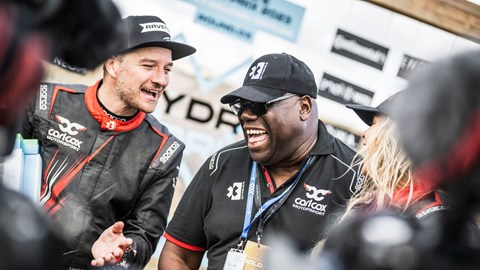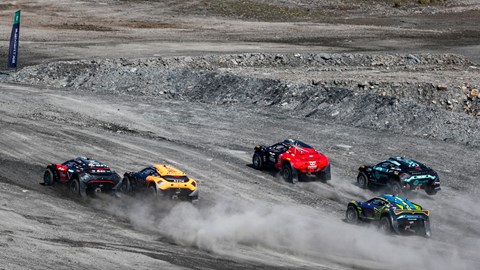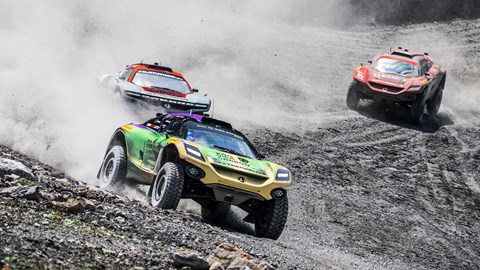► We report from the ground
► Extreme E is now in its third season
► What’s working and what isn’t
Now in its third season, the all-electric off-road Extreme E championship has just visited Scotland for the first time. Held in a former mine near Dumfries, this was billed as the Hydro X Prix. ‘Hydro’ because it put the focus on hydro-electric energy and clean rivers, both of which are a big deal in Scotland. And ‘X Prix’ because that’s what the championship calls its events, just as Formula E favours E Prix.
There are five events this year, each of them a double-header. The first was the Desert X Prix in Saudi Arabia, and the season will end in Chile with the Copper X Prix.
Ten teams take part, with one car per team and two drivers, one male and one female, with a compulsory driver change in every heat and final.

Some of the big-name drivers, including Jenson Button and Sébastien Loeb, have moved on, with a flush influx of rallycross talent, but Button remains as a team boss, as does Lewis Hamilton, and motorsport-obsessed superstar DJ Carl Cox has now joined their number. Manufacturers taking part include Cupra and Hummer, although all the cars are identical.
1. XE is showing the way ahead
You may be immune to the charms of Extreme E, the all-electric off-road series that’s on a mission to promote sustainability, but you can be sure it’s being watched very closely by the organisers of other motorsport categories. What works, what doesn’t work, and what’s attracting the clicks and likes and retweets. While other series are still in various stages of hybrid, World Rallycross has gone electric in the wake of Extreme E.
Neom McLaren’s Tanner Foust says: ‘I think anybody racing for a car manufacturer now is in discussions about, or is actually driving, an EV race car.’ The American made his name in rallying and rallycross, but was also involved in VW’s ID. R Pikes Peak electric project, and has raced an ID. 4-based Baja buggy.
‘At the moment in EV racing, I think the goal of each driver is to make it feel like an analogue car, to make it familiar. As we move through the years of EV racing, our driving will evolve to be able to take a little bit more advantage of some of those digital possibilities.’

Electric racing as a tool for promoting road cars has gone through several evolutions, he says. ‘First, show people that they’re fast. Now everybody knows that the EV at the traffic lights is the quickest. Then show people that they’re safe and rugged. So you see these things bouncing around and jumping around off-road and that’s done the job.
‘One thing I love about Extreme E is it has shown that you can still race and it’s not a bad word. It’s futureproofed the sport.’
2. The 50:50 gender split is making a real difference
The short-lived W Series may have given high-profile exposure to female racers, but didn’t give them the opportunity to show what they could do on a level playing field competing with and against men. Extreme E insists that every team has one male, one female driver, swapping part-way through each race. It’s up to the teams to decide which of their drivers goes first, so you organically get males and females on track at the same time.
Neom McLaren’s Emma Gilmour says: ‘The equal 50:50 paddock of males and females has opened a lot of doors for women. No other motorsport has come close to it.
‘I’ve had many opportunities overseas because I’ve been a female driver, and you bring something different to the team, but they don’t necessarily want you to be competitve. It’s ticking the box.

‘Here you are as important in the car as your male team-mate. It changes the game. It’s opened a lot of people’s eyes – they can see what happens when girls are given the same opportunity and same equipment, it gives them a chance to shine.’
But there are still obstacles.
‘A lot of the male drivers here have other very extensive programmes that allow them a lot of seat time. Not so many of the female drivers have that as well, so it’s still a challenge for us to come in with not so much seat time as some of the rallycross drivers or the desert drivers.’
Acciona Sainz’s Laia Sanz says: ‘The level has improved a lot. There are no weak teams. The level of the girls is nice to see. Compared to the first year it’s crazy how we’ve improved.’
And Cristina Gutiérrez, who drives for Lewis Hamilton’s X44 Vida Carbon Racing team, says: ‘All the teams can win.’

3. The racing is much more intense in person
In Scotland, getting to the super-narrow turn one first was all important. There were overtaking opportunities later in the lap, but not many. As all the cars are the same, give or take the paintwork and some crash damage, driver ruthlessness counts double.
All the things you’re used to as signifiers of motorsport excitement – revving engines, burning oil, cheering spectators – are absent. But up close, these quiet electric buggies are being driven like the devil’s on their tail.
Also, they look really weird. They already look peculiar on screen, a bit like something out of Forza, but they’re differently weird in person. It’s a lot like you’ve wandered on to a Power Rangers shooting location. (Or, for older readers, like Gerry Anderson’s amazing Supermarionation veichles – Joe 90’s car, the Stingraysubmarine, Parker’s Rolls-Royce – have entered reality.)
4. It’s still a work in progress
The race format could definitely do with further tweaks. Too many heats, not enough laps for the main race, for instance. But there are also some non-racing changes that could easily be made. For instance, although the shuttle bus from the car park to the paddock is electric, there’s a lot of Range Rovers ferrying VIPs to and fro. And, heavens help us, the winners spraying champagne on the podium – really, in a sustainability-focused series?

Harder to avoid is an air ambulance helicopter, regular ambulances and various support vehicles – pick-ups, buggies – that are not terribly green.
As Neom McLaren’s Tanner Foust says: ‘There’s a lot of criticism, because there might be a lot of environmental initiatives but only two or three of them take. But those are two or three things that wouldn’t even have happened before.
‘For example everybody in the paddock carries their own cutlery around to every event, and that seems like one small thing, but it’s a pretty big deal when you’re travelling with a huge group of people into these environments. Now I’m hearing of other series adopting it, and they have much more people in their footprint.’
5. Everyone loves Seb
Sébastien Loeb, the nine-times World Rally champion, competed with some success in the first two seasons of Extreme E, in between his various Dakar and WRC commitments. He’s not in XE this year, as he’s now focused largely on the World Rally Raid Championship.
But he certainly left his mark on those he raced against. Tanner Foust recalls: ‘Last year, there was the Loeb line, as everybody called it. The tracks tended to have multiple lines, and Loeb would try something else again – and smoke everybody. He’s something special.

‘There isn’t anybody in the WRC world who would deny that if he entered an event right now he wouldn’t be a threat.’
And Abt Cupra’s Nasser Al-Attiyah – no mean driver himself, with five Dakar wins (to Loeb’s zero) and currently leading the World Rally Raid series – doffs his cap to the Frenchman: ‘Seb is one of the great drivers in motorsport.’ So why does he keep not quite winning Dakar? ‘Dakar is totally different. You need to have really different skill. He has the speed. But he needs the experience. I am sure he can win in the future.’ But you’ll try to stop him? ‘Absolutely I will.’